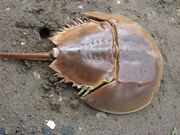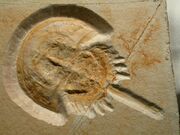
extant http://sandwalk.blogspot.com/2012/01/evolution-of-horseshoe-crabs.html

Fossil record http://www.fossilmuseum.net/Fossil_Sites/solnhofen/Mesolimulus-walchi/Mesolimulus.htm
Dynamic Stasis according to Freeman & Herron (2004), is "lack of morphological change over a long term interval of evolution, despite many short-term changes during the same interval. No or little net evolution".
Morphological changes are defines as changes in structure or form (Freeman & Herron, 2004). Because morphological changes are structural changes, they are generally easy to detect. In the case of dynamic stasis, little or no morphological changes occur over a long interval of time.
It is interesting that when dynamic stasis occurs, when extant populations are examined, changes have occured phenotypically and genetically (Eldredge et. al, 2005).
The horseshoe crab is a great example of an animal that displays dynamic stasis. Extant populations and fossil records are morphologically basically identical (Freemand & Herron, 2004).
Additional Readings[]
http://www.tiem.utk.edu/~gavrila/PAPS/stasis.pdf
Works Cited[]
Eldredge, N., Thompson, J. N., Brakefield, P. M., Gavrilets, S., Jablonski, D., Jackson, J. B., ... & Miller III, W. (2005). The dynamics of evolutionary stasis. Paleobiology, 31(sp5), 133-145.
Freeman, S. & Herron, J. (2004). Evolutionary Analysis 3rd Ed. The Cambrian Explosion and Beyone, pp 663-700.